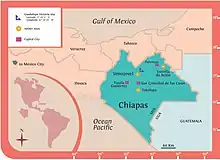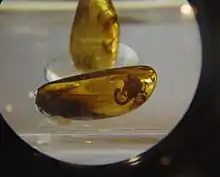
Mexican amber, also known as Chiapas Amber is amber found in Mexico, created during the Early Miocene and middle Miocene epochs of the Cenozoic Era in southwestern North America. As with other ambers, a wide variety of taxa have been found as inclusions including insects[1][2][3][4][5] and other arthropods,[6] as well as plant fragments[7] and epiphyllous fungi.[8]
Context

Mexican amber is mainly recovered from fossil bearing rocks in the Simojovel region of Chiapas, Mexico. It is one of the main minerals recovered in the state of Chiapas, much of which is from 15 to 23 million years old, with quality comparable to that found in the Dominican Republic. Chiapan amber has a number of unique qualities, including much that is clear all the way through and some with fossilized insects and plants. Most Chiapan amber is worked into jewelry including pendants, rings and necklaces. Colors vary from white to yellow/orange to a deep red, but there are also green and pink tones as well. Since pre-Hispanic times, native peoples have believed amber to have healing and protective qualities.
The largest amber mine is in Simojovel, a small village 130 km from Tuxtla Gutiérrez, which produces 95% of Chiapas' amber. Other mines are found in Huitiupán, Totolapa, El Bosque, Pueblo Nuevo Solistahuacán, Pantelhó and San Andrés Duraznal. According to the Museum of Amber in San Cristóbal, almost 300 kg of amber is extracted per month from the state. Prices vary depending on quality and color.
The amber dates from between 15 million years old, for the youngest sediments of the Balumtun Sandstone and 22.5 million years old for the oldest La Quinta Formation.
Origin
The amber was produced by either the two extinct leguminous trees Hymenaea mexicana or Hymenaea allendis, both of which were initially described from fossil flowers included in Mexican amber.[9]
Fossil inclusions

The Tityus apozonalli scorpion holotype fossil is composed of a very complete adult male recovered from the Guadalupe Victoria site.[10] The amber dates from between 23 million years old at the oldest and 15 million years at the youngest. The Guadalupe Victoria site is an outcrop of amber bearing strata belonging to the Mazantic Shale and Balumtum Sandstone. The deposits preserve a transitional river or stream environments near the coast and preserves fossils of a mangrove forest ecosystem.[10] Asteromites mexicanus is an epiphyllous coelomycetes fungus species recovered on a petal.[8] Nine specimens of Miocene crabs are known as inclusions in Chiapas amber.[11]
Arthropod species
- Agria sp. (a damselfly)[12]
- Amblypsilopus monicae Bickel 2016 (long-legged fly)
- Anbarrhacus adamantis (a millipede)
- Aphaenogaster praerelicta (an ant)
- Cenocephalus tenuis Peris and Solórzano Kraemer 2015 (ambrosia beetle)
- Culoptila aguilerai (a caddisfly)
- Dicromantispa electromexicana (a mantidfly)
- Erpetogomphus sp. (a dragonfly)[12]
- Hyptia deansi (a wasp)
- Leptopharsa tacanae (a lace bug)
- Litaneutria pilosuspedes Terriquez et al. 2022 (mantis)[13]
- Maatidesmus paachtun (a millipede)
- Mastotermes electromexicus (a termite)
- Medetera amissa Bickel 2016 (long-legged fly)
- Medetera totolapa Bickel 2016 (long-legged fly)
- Mesorhaga pseudolacrymans Bickel 2016 (long-legged fly)[14]
- Neoparentia chiapensis Bickel 2016 (long-legged fly)
- Parastemmiulus elektron (a millipede)
- Peloropeodes paleomexicana Bickel 2016 (long-legged fly)
- Schwenckfeldina archoica (a fungus gnat)
- Termitaradus protera (a termite bug)
- Tesserocerus simojovelensis Peris and Solórzano Kraemer 2015 (ambrosia beetle)[15]
- Tityus apozonalli (a scorpion)
- Tityus knodeli (a scorpion)
- Tonocatecutlius sp. (a planthopper)
References
- ↑ De Andrade, M. L. (1995). "The ant genus Aphaenogaster in Dominican and Mexican amber (Amber Collection Stuttgart: Hymenoptera, Formicidae. IX: Pheidolini)". Stuttgarter Beiträge zur Naturkunde. Serie B (Geologie und Paläontologie). 223: 1–11.
- ↑ Engel, Michael S.; Grimaldi, David A. (September 2007). "The Neuropterid Fauna of Dominican and Mexican Amber (Neuropterida: Megaloptera, Neuroptera)". American Museum Novitates (3587): 1–58. doi:10.1206/0003-0082(2007)3587[1:TNFODA]2.0.CO;2. hdl:2246/5880. S2CID 49393365.
- ↑ Jennings, John T.; Krogmann, Lars; Mew, Steven L. (18 June 2012). "Hyptia deansi sp. nov., the first record of Evaniidae (Hymenoptera) from Mexican amber". Zootaxa. 3349 (1): 63. doi:10.11646/zootaxa.3349.1.7. S2CID 1615260.
- ↑ Krishna, Kumar; Emerson, Alfred Edwards (1983). "A new fossil species of termite from Mexican amber, Mastotermes electromexicus (Isoptera, Mastotermitidae)". American Museum Novitates. hdl:2246/5310.
- ↑ Solórzano Kraemer, M. M.; Mohrig, W. (2007). "Schwenckfeldina archoica sp. nov. (Diptera, Sciaridae) from the middle Miocene Mexican amber" (PDF). Alavesia. 1: 105–108. S2CID 90676751.
- ↑ Solórzano Kraemer, Mónica (10 December 2007). "Systematic, palaeoecology, and palaeobiogeography of the insect fauna from Mexican amber". Palaeontographica Abteilung A. 282 (1–6): 1–133. doi:10.1127/pala/282/2007/1.
- ↑ Heinrichs, Jochen; Schäfer-Verwimp, Alfons; Boxberger, Julia; Feldberg, Kathrin; Solórzano Kraemer, Mónica M.; Schmidt, Alexander R. (19 March 2014). "A fossil species of Ceratolejeunea (Lejeuneaceae, Porellales) preserved in Miocene Mexican amber". The Bryologist. 117 (1): 10–14. doi:10.1639/0007-2745-117.1.010. S2CID 83696803.
- 1 2 Poinar, George (January 2003). "Coelomycetes in Dominican and Mexican amber". Mycological Research. 107 (1): 117–122. doi:10.1017/s0953756202007001. PMID 12735252.
- ↑ Calvillo-Canadell, L.; Cevallos-Ferriz, S.R.S.; Rico-Arce, L. (2010). "Miocene Hymenaea flowers preserved in amber from Simojovel de Allende, Chiapas, Mexico". Review of Palaeobotany and Palynology. 160 (3–4): 126–134. doi:10.1016/j.revpalbo.2010.02.007.
- 1 2 Riquelme, F.; Villegas-Guzmán, G.; González-Santillán, E.; Córdova-Tabares, V.; Francke, O. F.; Piedra-Jiménez, D.; Estrada-Ruiz, E.; Luna-Castro, B. (2015). "New Fossil Scorpion from the Chiapas Amber Lagerstätte". PLOS ONE. 10 (8): 1–20. Bibcode:2015PLoSO..1033396R. doi:10.1371/journal.pone.0133396. PMC 4526686. PMID 26244974.
- ↑ Serrano-Sánchez, María de Lourdes; Guerao, Guillermo; Centeno-García, Elena; Vega, Francisco J.; Serrano-Sánchez, María de Lourdes; Guerao, Guillermo; Centeno-García, Elena; Vega, Francisco J. (2016). "Crabs (Brachyura: Grapsoidea: Sesarmidae) as inclusions in Lower Miocene amber from Chiapas, Mexico". Boletín de la Sociedad Geológica Mexicana. 68 (1): 37–43. doi:10.18268/BSGM2016v68n1a6.
- 1 2 Zheng, Daran; Nel, André; Jarzembowski, Edmund A.; Chang, Su-Chin; Zhang, Haichun; Wang, Bo (2019-01-02). "Exceptionally well-preserved dragonflies (Insecta: Odonata) in Mexican amber". Alcheringa: An Australasian Journal of Palaeontology. 43 (1): 157–164. doi:10.1080/03115518.2018.1456562. ISSN 0311-5518. S2CID 134070211.
- ↑ Terríquez-Beltrán, J.; Riquelme, F.; Varela-Hernández, F. (2022-10-31). "A new species of mantis (Insecta: Mantodea: Amelidae) from the Miocene Amber-Lagerstätte in Mexico". Historical Biology: 1–8. doi:10.1080/08912963.2022.2134782. ISSN 0891-2963. S2CID 253280592.
- ↑ Daniel J. Bickel; Monica M. Solórzano Kraemer (2016). "The Dolichopodidae (Diptera) of Mexican amber". Boletín de la Sociedad Geológica Mexicana.
- ↑ Peris, David; Solórzano Kraemer, Mónica M.; Peñalver, Enrique; Delclòs, Xavier (September 2015). "New ambrosia beetles (Coleoptera: Curculionidae: Platypodinae) from Miocene Mexican and Dominican ambers and their paleobiogeographical implications". Organisms Diversity & Evolution. 15 (3): 527–542. doi:10.1007/s13127-015-0213-y. S2CID 8619185.
External links
 Media related to Mexican amber at Wikimedia Commons
Media related to Mexican amber at Wikimedia Commons